What We’re Reading: February 16th
Guest Editor: Dr. Amey Redkar
 Amey is a postdoc at The Sainsbury Laboratory, Norwich, UK and has been a Plantae Fellow since September 2017. He is working to understand the interaction of plants and pathogens during disease development. His current research which is funded by EMBO Long Term Fellowship focuses on pathogen Albugo candida, which causes serious disease in Brassica crops and aim to understand the role of virulence proteins. Understanding this pathogen flexibility on different plant species, with ultimate help to generate Brassicas resistant to this disease. His long- term interest is to dissect cell-specific sensing mechanism in filamentous plant pathogens which will be started later in 2018 with a Marie Skłodowska Curie Fellowship. Read more about his research here
Amey is a postdoc at The Sainsbury Laboratory, Norwich, UK and has been a Plantae Fellow since September 2017. He is working to understand the interaction of plants and pathogens during disease development. His current research which is funded by EMBO Long Term Fellowship focuses on pathogen Albugo candida, which causes serious disease in Brassica crops and aim to understand the role of virulence proteins. Understanding this pathogen flexibility on different plant species, with ultimate help to generate Brassicas resistant to this disease. His long- term interest is to dissect cell-specific sensing mechanism in filamentous plant pathogens which will be started later in 2018 with a Marie Skłodowska Curie Fellowship. Read more about his research here
Review. Rise of a cereal killer: The biology of Magnaporthe oryzae biotrophic growth
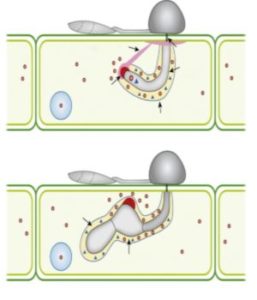 The fungal pathogen Magnaporthe oryzae causes one of the most destructive diseases of rice, destroying around 10-30% of rice production world-wide. The pathogen undergoes different developmental changes and produce specialized infectious structures in order to rapidly proliferate within the host cells. The detailed molecular processes of how the fungus co-ordinates this complex infection pattern is still not well understood. Fernandez and Orth in this recent review, have reflected on the recent advances and understanding of the cell biology and molecular factors that lead to this disease establishment. The authors highlight host sensing and appressorium formation which is coupled with environmental sensing by modulation of the MAP kinase signalling pathways. The conidia undergo cell cycle progression and autophagic cell death to form appressorium, that subsequently builds a massive turgor pressure translated into physical force to enter the host. Once inside, there is developmental re-programming to form filamentous infectious hyphae that promote the cell to cell pathogen spread. Several effector proteins help in shaping the interaction with distinct localisation pattern between cytoplasmic and apoplastic effectors. Additionally hormonal homeostasis is disrupted in order to facilitate nutrient uptake. Further research on composition of apoplastic matrix and mechanism underlying the processes targeted by effectors would help to understand M. oryzea biology in much detail. (Summary by Amey Redkar) Trends Microbiol. 10.1016/j.tim.2017.12.007
The fungal pathogen Magnaporthe oryzae causes one of the most destructive diseases of rice, destroying around 10-30% of rice production world-wide. The pathogen undergoes different developmental changes and produce specialized infectious structures in order to rapidly proliferate within the host cells. The detailed molecular processes of how the fungus co-ordinates this complex infection pattern is still not well understood. Fernandez and Orth in this recent review, have reflected on the recent advances and understanding of the cell biology and molecular factors that lead to this disease establishment. The authors highlight host sensing and appressorium formation which is coupled with environmental sensing by modulation of the MAP kinase signalling pathways. The conidia undergo cell cycle progression and autophagic cell death to form appressorium, that subsequently builds a massive turgor pressure translated into physical force to enter the host. Once inside, there is developmental re-programming to form filamentous infectious hyphae that promote the cell to cell pathogen spread. Several effector proteins help in shaping the interaction with distinct localisation pattern between cytoplasmic and apoplastic effectors. Additionally hormonal homeostasis is disrupted in order to facilitate nutrient uptake. Further research on composition of apoplastic matrix and mechanism underlying the processes targeted by effectors would help to understand M. oryzea biology in much detail. (Summary by Amey Redkar) Trends Microbiol. 10.1016/j.tim.2017.12.007
Review. Plant cell wall-mediated immunity: cell wall changes trigger disease resistance responses
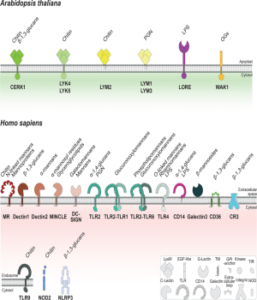 Plant cell walls have recently been revealed as an essential factor of plant environment monitoring system, much more than just a passive defensive barrier as previously thought. In a recent work, Bacete et al. have reviewed how changes to plant cell wall integrity affect disease resistance. More specifically, how the impairment of cellulose biosynthesis, the degree of modification of pectins and even the content and degree of acetylation of hemicellulose polysaccharides influence plant disease resistance. Current understanding on how alterations are perceived by plant cells is still scarce; nevertheless the authors list what is known on the molecular mechanisms for the perception of cell wall integrity alterations and subsequent activation of defense responses, including what is known for the osmo- and mechano-perception sensor systems in plants, the role and nature of pattern recognition receptors (PPRs) and damage-associated molecular patterns (DAMPs). (Summary by Isabel Mendoza) Plant J. 10.1111/tpj.13807
Plant cell walls have recently been revealed as an essential factor of plant environment monitoring system, much more than just a passive defensive barrier as previously thought. In a recent work, Bacete et al. have reviewed how changes to plant cell wall integrity affect disease resistance. More specifically, how the impairment of cellulose biosynthesis, the degree of modification of pectins and even the content and degree of acetylation of hemicellulose polysaccharides influence plant disease resistance. Current understanding on how alterations are perceived by plant cells is still scarce; nevertheless the authors list what is known on the molecular mechanisms for the perception of cell wall integrity alterations and subsequent activation of defense responses, including what is known for the osmo- and mechano-perception sensor systems in plants, the role and nature of pattern recognition receptors (PPRs) and damage-associated molecular patterns (DAMPs). (Summary by Isabel Mendoza) Plant J. 10.1111/tpj.13807
Review. The coming of age of EvoMPMI: evolutionary molecular plant-microbe interactions across multiple timescales
 Often, a wide gap exists between evolutionary research, that is focused on theoretical approaches and organism evolution across multiple timescales, and molecular research aspiring to solve mechanistic puzzles of how particular systems work. Plant Biology is no exception to this, and much can be learnt of plant-microbe interactions by combining mechanistic research with evolutionary approaches which is emerging in recent years. A recent review by Upson et al. summarises the most recent advances made in plant-microbe interactions from studies focusing on how ancient plants evolved through interactions with microorganisms, and the continuous arms race between the plant immune system and successful infection by pathogens.The authors highlight the concept of convergent evolution of unrelated plant pathogens due to similar selective pressures by the plant immune response to infection, and comparably, how pathogens have left footprints on evolving plant genomes. Studying both the evolutionary and molecular aspects of plant-microbe interactions will greatly advance our understanding and help to understand new perspectives of this interesting field of plant science. (Summary by Danielle Roodt Prinsloo) BioRxiv. 10.1101/254755
Often, a wide gap exists between evolutionary research, that is focused on theoretical approaches and organism evolution across multiple timescales, and molecular research aspiring to solve mechanistic puzzles of how particular systems work. Plant Biology is no exception to this, and much can be learnt of plant-microbe interactions by combining mechanistic research with evolutionary approaches which is emerging in recent years. A recent review by Upson et al. summarises the most recent advances made in plant-microbe interactions from studies focusing on how ancient plants evolved through interactions with microorganisms, and the continuous arms race between the plant immune system and successful infection by pathogens.The authors highlight the concept of convergent evolution of unrelated plant pathogens due to similar selective pressures by the plant immune response to infection, and comparably, how pathogens have left footprints on evolving plant genomes. Studying both the evolutionary and molecular aspects of plant-microbe interactions will greatly advance our understanding and help to understand new perspectives of this interesting field of plant science. (Summary by Danielle Roodt Prinsloo) BioRxiv. 10.1101/254755
RAF2 is a Rubisco Assembly Factor in Arabidopsis thaliana
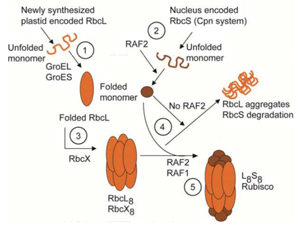 The assembly of the carbon fixing enzyme Rubisco is a complex process and involves many chaperones including RAF1, RbcX and the chaperonins. Recent evidence pointed to the existence of another chaperone, RAF2, conserved among photosynthetic organisms. The protein has similarity to pterin-4α-carbinolamine dehydratase (PCD), although appears to lack activity in the species studied to date. Fristedt et al. assessed the influence of RAF2 on Rubisco assembly in Arabidopsis thaliana. Using an anti-RAF2 antibody, the authors showed that RAF2 accumulates prior to Rubisco during greening and is largely confined to the chloroplast stroma. raf2 mutants were slower-growing and appear paler than wild-type (WT) plants, an effect exacerbated in short days. The mutants demonstrated normal formation of thylakoid membranes and had WT levels of proteins constituting the photosynthetic electron transport chain. However, there was a dramatic reduction in the level of Rubisco in raf2 mutants, which led to reduced carbon assimilation at irradiances above 200 μmol m-2 s-1. Formation of aggregates of Rubisco large subunits in raf2 seedlings suggests RAF2 may be involved in chaperoning small subunits to/into large subunit complexes. (Summary by Mike Page) Plant J. 10.1111/tpj.13849
The assembly of the carbon fixing enzyme Rubisco is a complex process and involves many chaperones including RAF1, RbcX and the chaperonins. Recent evidence pointed to the existence of another chaperone, RAF2, conserved among photosynthetic organisms. The protein has similarity to pterin-4α-carbinolamine dehydratase (PCD), although appears to lack activity in the species studied to date. Fristedt et al. assessed the influence of RAF2 on Rubisco assembly in Arabidopsis thaliana. Using an anti-RAF2 antibody, the authors showed that RAF2 accumulates prior to Rubisco during greening and is largely confined to the chloroplast stroma. raf2 mutants were slower-growing and appear paler than wild-type (WT) plants, an effect exacerbated in short days. The mutants demonstrated normal formation of thylakoid membranes and had WT levels of proteins constituting the photosynthetic electron transport chain. However, there was a dramatic reduction in the level of Rubisco in raf2 mutants, which led to reduced carbon assimilation at irradiances above 200 μmol m-2 s-1. Formation of aggregates of Rubisco large subunits in raf2 seedlings suggests RAF2 may be involved in chaperoning small subunits to/into large subunit complexes. (Summary by Mike Page) Plant J. 10.1111/tpj.13849
Ethylene signaling modulates cortical microtubule reassembly in response to salt stress
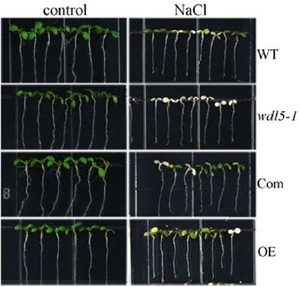 Ethylene is an important mediator during plant adaptation to salt stress. During salt stress, ethylene has been shown to promote microtubule (MT) stability and organization. Dou et al. further examine this pathway using Ag+ to block ethylene signaling in addition to using various mutants. In wildtype and ethylene overexpression mutants, adding NaCl and Ag+ hastened seedling death compared to salt alone. However, mutants which constitutively active ethylene signaling were resistant to salt treatment regardless of Ag+ presence. MT depolymerization immediately following salt stress was also unaffected by Ag+ but MT reassembly in later salt stress response was blocked by exogenous Ag+. Furthermore, the MT stabilizing proteins EIN3 and EIN1 were also found to be required for the later MT reassembly during salt stress. These data elucidate the mechanism of ethylene signaling and exemplifies the importance of MT reassembly during the later stages of salt stress. (Summary by Alecia Biel) Plant Physiol. 10.1104/pp.17.01124.
Ethylene is an important mediator during plant adaptation to salt stress. During salt stress, ethylene has been shown to promote microtubule (MT) stability and organization. Dou et al. further examine this pathway using Ag+ to block ethylene signaling in addition to using various mutants. In wildtype and ethylene overexpression mutants, adding NaCl and Ag+ hastened seedling death compared to salt alone. However, mutants which constitutively active ethylene signaling were resistant to salt treatment regardless of Ag+ presence. MT depolymerization immediately following salt stress was also unaffected by Ag+ but MT reassembly in later salt stress response was blocked by exogenous Ag+. Furthermore, the MT stabilizing proteins EIN3 and EIN1 were also found to be required for the later MT reassembly during salt stress. These data elucidate the mechanism of ethylene signaling and exemplifies the importance of MT reassembly during the later stages of salt stress. (Summary by Alecia Biel) Plant Physiol. 10.1104/pp.17.01124.
Dynamic thylakoid stacking regulates the balance between linear and cyclic photosynthetic electron transfer
 The activation of photosynthetic electron transport upon a dark-to-light transition occurs prior to the initiation of CO2 fixation by Rubisco in the Calvin cycle. A mechanism known as cyclic electron transfer (CET) exists that generates the proton motive force required to drive ATP synthesis without an accumulation of NADPH, thereby protecting photosystem I during this lag. Dark-to-light transitions also lead to the phosphorylation of the light harvesting complexes of photosystem II (LHCII). Wood et al. demonstrate that increased LHCII phosphorylation does not alter the relative sizes of the photosystem antennae as seen in state transitions. Instead, they show that it leads to a weakening of LHCII-LHCII interactions, resulting in smaller but more numerous grana, and so gives rise to conditions that favour linear electron transfer (LET) over CET. This work reveals how dynamic changes in thylakoid architecture can affect the balance between LET and CET in response to a changing light environment. (Summary by Mike Page) Nat. Plants. 10.1038/s41477-017-0092-7
The activation of photosynthetic electron transport upon a dark-to-light transition occurs prior to the initiation of CO2 fixation by Rubisco in the Calvin cycle. A mechanism known as cyclic electron transfer (CET) exists that generates the proton motive force required to drive ATP synthesis without an accumulation of NADPH, thereby protecting photosystem I during this lag. Dark-to-light transitions also lead to the phosphorylation of the light harvesting complexes of photosystem II (LHCII). Wood et al. demonstrate that increased LHCII phosphorylation does not alter the relative sizes of the photosystem antennae as seen in state transitions. Instead, they show that it leads to a weakening of LHCII-LHCII interactions, resulting in smaller but more numerous grana, and so gives rise to conditions that favour linear electron transfer (LET) over CET. This work reveals how dynamic changes in thylakoid architecture can affect the balance between LET and CET in response to a changing light environment. (Summary by Mike Page) Nat. Plants. 10.1038/s41477-017-0092-7
Ancient duons may underpin spatial patterning of gene expression in C4 leaves
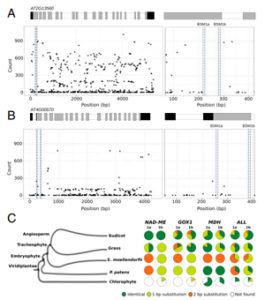 C4 photosynthesis describes a biochemical CO2-concentrating mechanism that relies on the spatial separation of biochemistry between two cell types, mesophyll cells (MCs) and bundle sheath cells (BSCs). However, there is currently little evidence on how some genes are preferentially expressed in BSCs over MCs. Reyna-Llorens et al. demonstrate that two cis regulatory motifs in the coding sequence of a BSC-expressed gene (NAD-dependent MALIC ENZYME1 from Gynandropsis gynandra, GgNAD-ME1) repress transcription of this gene in MCs. In order for repression to occur in MCs, both ‘duons’ must be present and separated by 240-550 nucleotides. Similar motifs were found in other genes preferentially expressed in BSCs, and are likely to represent recruitment sites for as-yet unidentified transcription factors. (Summary by Mike Page) Proc. Natl. Acad. Sci. USA 10.1073/pnas.1720576115
C4 photosynthesis describes a biochemical CO2-concentrating mechanism that relies on the spatial separation of biochemistry between two cell types, mesophyll cells (MCs) and bundle sheath cells (BSCs). However, there is currently little evidence on how some genes are preferentially expressed in BSCs over MCs. Reyna-Llorens et al. demonstrate that two cis regulatory motifs in the coding sequence of a BSC-expressed gene (NAD-dependent MALIC ENZYME1 from Gynandropsis gynandra, GgNAD-ME1) repress transcription of this gene in MCs. In order for repression to occur in MCs, both ‘duons’ must be present and separated by 240-550 nucleotides. Similar motifs were found in other genes preferentially expressed in BSCs, and are likely to represent recruitment sites for as-yet unidentified transcription factors. (Summary by Mike Page) Proc. Natl. Acad. Sci. USA 10.1073/pnas.1720576115
Genomewide association study of ionomic traits on diverse soybean populations from germplasm collections
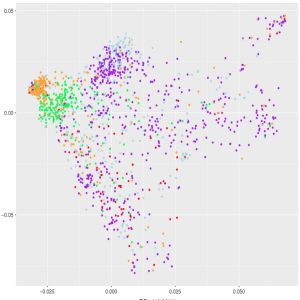 Germplasm collections are invaluable resources for plant science and the elemental content of the seeds is a strong indication of the plant’s response to its specific environment. In this study, Ziegler et al. have selected 1,653 soybean accessions from the USDA Soybean Germplasm Collection and seeds came from grow-outs in 14 different location-by-year combinations. Then, the elemental profile of seeds was assayed and lines were genotyped using SoySNP50K beadchip. After fitting a multilocus mixed model for the 20 ionomic traits measured, different sets of SNPs were identified depending on the experiment and the stringency level. HAM13, a gene previously shown to be involved in cadmium content in soybean, was the candidate gene underlying a locus strongly associated with cadmium content. Hence, this study showed the possibility of using ionomic traits of seeds from germplasm collection to identify markers linked to genes important for crop improvement. (Summary by Stephanie Saade) Plant Direct. 10.1002/pld3.33
Germplasm collections are invaluable resources for plant science and the elemental content of the seeds is a strong indication of the plant’s response to its specific environment. In this study, Ziegler et al. have selected 1,653 soybean accessions from the USDA Soybean Germplasm Collection and seeds came from grow-outs in 14 different location-by-year combinations. Then, the elemental profile of seeds was assayed and lines were genotyped using SoySNP50K beadchip. After fitting a multilocus mixed model for the 20 ionomic traits measured, different sets of SNPs were identified depending on the experiment and the stringency level. HAM13, a gene previously shown to be involved in cadmium content in soybean, was the candidate gene underlying a locus strongly associated with cadmium content. Hence, this study showed the possibility of using ionomic traits of seeds from germplasm collection to identify markers linked to genes important for crop improvement. (Summary by Stephanie Saade) Plant Direct. 10.1002/pld3.33
A NIN-LIKE PROTEIN mediates nitrate-induced control of root nodule symbiosis in Lotus japonicus
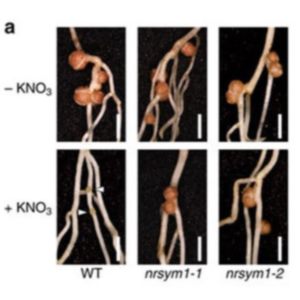 Legumes form root endosymbioses with Rhizobium bacteria in a special structure called nodule. In this symbiotic relationship, on one hand the plant provides the microbe with sugars and in exchange it receives fixed atmospheric nitrogen, the main limiting element for plant growth. Nevertheless, when nitrogen is abundant, at the concentration of 10-50 mM, the plant does not establish symbiosis anymore. In their work, Nishida et al. described and characterized a new transcription factor from Lotus japonicus called NITRATE UNRESPONSIVE SYMBIOSIS 1 (NRSYM1) that guaranteed to the plant to monitor nitrogen levels and regulate nodule formation. NRSYM1 is activated by nitrate and directly intermediates the production of CLE-RS2, a mobile peptide produced in the root that negatively regulate nodule number. Therefore, NRSYM1 knock-out plants form nodules even at higher concentration of nitrogen. (Summary by Marco Giovannetti) Nature Comms. 10.1038/s41467-018-02831-x
Legumes form root endosymbioses with Rhizobium bacteria in a special structure called nodule. In this symbiotic relationship, on one hand the plant provides the microbe with sugars and in exchange it receives fixed atmospheric nitrogen, the main limiting element for plant growth. Nevertheless, when nitrogen is abundant, at the concentration of 10-50 mM, the plant does not establish symbiosis anymore. In their work, Nishida et al. described and characterized a new transcription factor from Lotus japonicus called NITRATE UNRESPONSIVE SYMBIOSIS 1 (NRSYM1) that guaranteed to the plant to monitor nitrogen levels and regulate nodule formation. NRSYM1 is activated by nitrate and directly intermediates the production of CLE-RS2, a mobile peptide produced in the root that negatively regulate nodule number. Therefore, NRSYM1 knock-out plants form nodules even at higher concentration of nitrogen. (Summary by Marco Giovannetti) Nature Comms. 10.1038/s41467-018-02831-x
Jasmonic acid and salicylic acid signaling in fern Azolla filiculoides and its cyanobiont
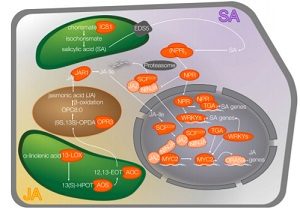 The phytohormones jasmonic acid (JA) and salicylic acid (SA) play key roles in how plants respond to microbes. However, this interplay between JA, SA and microbes is less understood in non-angiosperm linages. de Vries and colleagues examine JA/SA signalling between the water fern Azolla filiculoides and its nitrogen-fixing cyanobiont Nostoc azollae. They use data from large-scale sequencing to show that Azolla filiculoides has genes for the production and the sensing of JA and SA. Azolla filiculoides responds to exogenously applied SA, and SA application modifies the gene expression and abundance of the cyanobiont, Nostoc azollae. This paper describes JA/SA signalling in ferns and describes how SA plays a role in communication between Azolla filiculoides and its cyanobiont Nostoc azollae. (Summary by Julia Miller) Plant, Cell & Env. 10.1111/pce.13131
The phytohormones jasmonic acid (JA) and salicylic acid (SA) play key roles in how plants respond to microbes. However, this interplay between JA, SA and microbes is less understood in non-angiosperm linages. de Vries and colleagues examine JA/SA signalling between the water fern Azolla filiculoides and its nitrogen-fixing cyanobiont Nostoc azollae. They use data from large-scale sequencing to show that Azolla filiculoides has genes for the production and the sensing of JA and SA. Azolla filiculoides responds to exogenously applied SA, and SA application modifies the gene expression and abundance of the cyanobiont, Nostoc azollae. This paper describes JA/SA signalling in ferns and describes how SA plays a role in communication between Azolla filiculoides and its cyanobiont Nostoc azollae. (Summary by Julia Miller) Plant, Cell & Env. 10.1111/pce.13131



